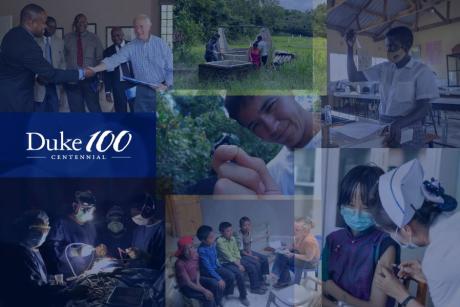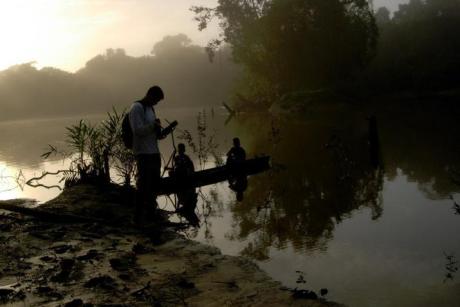
A health care worker collects a small blood sample from a Peruvian toddler as part of a large-scale assessment of human health around a protected area slated for mining and drilling.
Published August 12, 2014, last updated on April 9, 2018 under Research News
A Duke research team led by DGHI faculty William Pan has launched a new study to provide the first large-scale independent assessment of risks to human health and water resources from gas exploration and gold mining in one of the most biodiverse regions on Earth.
The study which began in July examines risks associated with drilling and mining in and around the Amarakaeri Communal Reserve, a protected area in southeastern Peru’s remote Madre de Dios region.
Scientists from the United States and Peru are taking part in the initiative, which is funded by a one-year, $1.9 million grant from Hunt Oil Company. Additional funding for three more years of study, worth roughly $1.7 million a year, is contingent on gas discovery in the area.
“Through this agreement, the company that stands to benefit from the extraction of the region’s natural resources also agrees to underwrite an independent scientific investigation to identify and monitor the impacts without any conditions on data sharing or publication of findings,” said Pan, assistant professor of global environmental health at Duke’s Nicholas School of the Environment and the Duke Global Health Institute.
The Amarakaeri reserve was established in 2002. It encompasses more than 1,500 square miles of ecologically important forests and headwater river basins and is home to the indigenous Harakmbut, Yine and Machiguenga peoples, who rely on the forests and rivers for food, water and other basic needs.
In 2006, the Peruvian government opened about 90 percent of the reserve to Texas-based Hunt Oil for gas exploration. Disputes over the potential environmental, human health and social justice impacts of drilling in the reserve have led to lawsuits and bloodshed, including the shooting deaths of 12 indigenous protesters by Peruvian police in 2009.
Small-scale artisanal gold mining has occurred in Madre de Dios since Inca times. In recent years, the pace and geographic extent of the operations have increased dramatically around the reserve as miners, spurred by rising gold prices, blast and clear more of the region’s forests and floodplains in search of new deposits. Hunt Oil is not involved in this mining.
“Our primary objectives are to establish baselines for human health and environmental conditions in and around Amarakaeri before exploratory drilling begins, and to monitor these indicators over time to see how continued mining and expanded drilling may affect key indicators,” Pan said.
The researchers will examine human biomarkers for cardiovascular and kidney function, nutrition, and infectious diseases in local populations to monitor the effects of exposure to particulates, mercury and other environmental risk factors from gas and gold mining operations. The project includes a comprehensive epidemiological study to evaluate how the clearing of forests for roads, agriculture, drill sites, mining, housing and support services affects the transmission of malaria and other diseases. The team will conduct hydrological assessments to identify potential impacts of gas extraction and gold mining on the local hydrological cycle and on downstream water quality. And they’ll work with local communities to develop strategies for improving public health.
“This information, much of which currently is critically lacking, is essential for developing long-term strategies for development in the region,” Pan said. “For example, creating reliable hydrological and transport models within the Madre de Dios region will help us better understand mercury distribution and exposure from mining activities and eventually the effect drilling will have in altering this distribution.” Such models, he explained, are necessary for projecting future impacts of increased industrialization in the region and devising ways to reduce or avoid them.
Duke faculty members working with Pan on the new study include Joel Meyer, Mukesh Kumar, Jennifer Swenson, Jim Zhang, and Marco Marani from the Nicholas School; Heileen Hsu-Kim from Duke’s Pratt School of Engineering, where Marani also holds a faculty appointment; Chris Woods and John Stanifer from Duke’s School of Medicine and the Duke Global Health Institute; and Ernesto Ortiz from the Duke Global Health Institute.
Other partners are Jaime Miranda of the Universidad Peruana Cayetano-Heredia in Lima, Peru, and Fred Stell and Gisella Vasquez of U.S. Naval Medical Research Unit No. 6.


